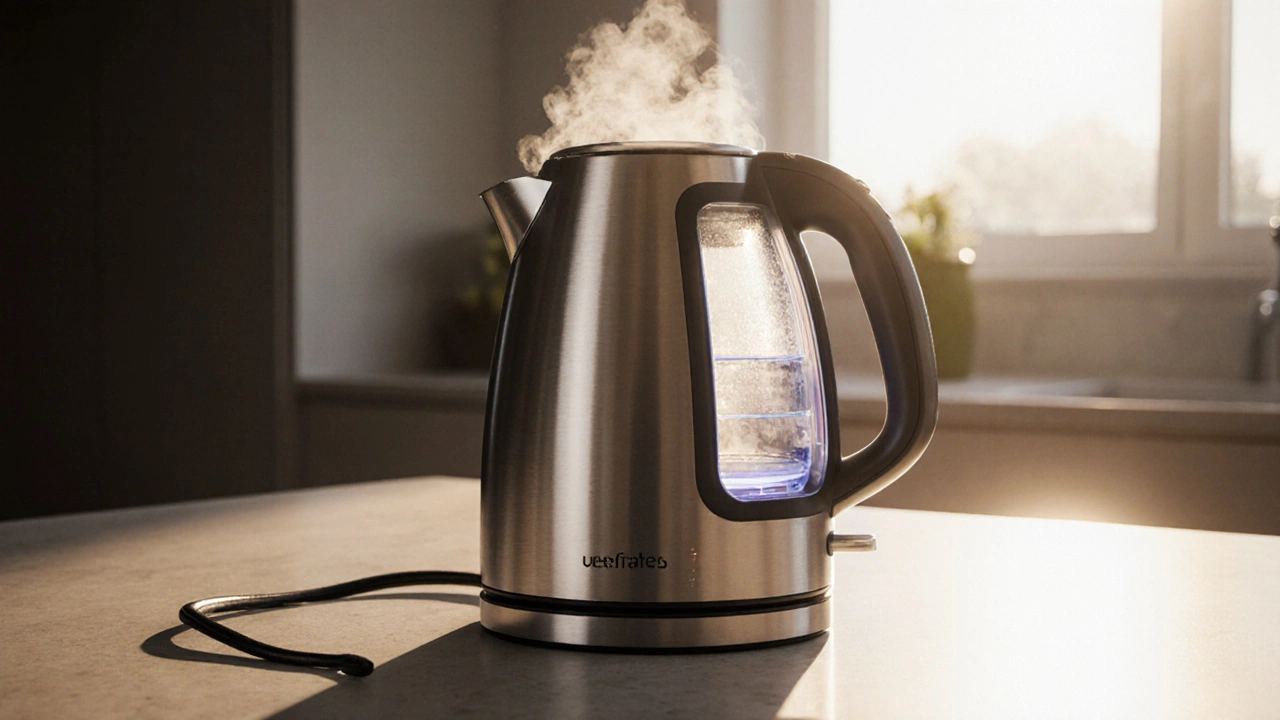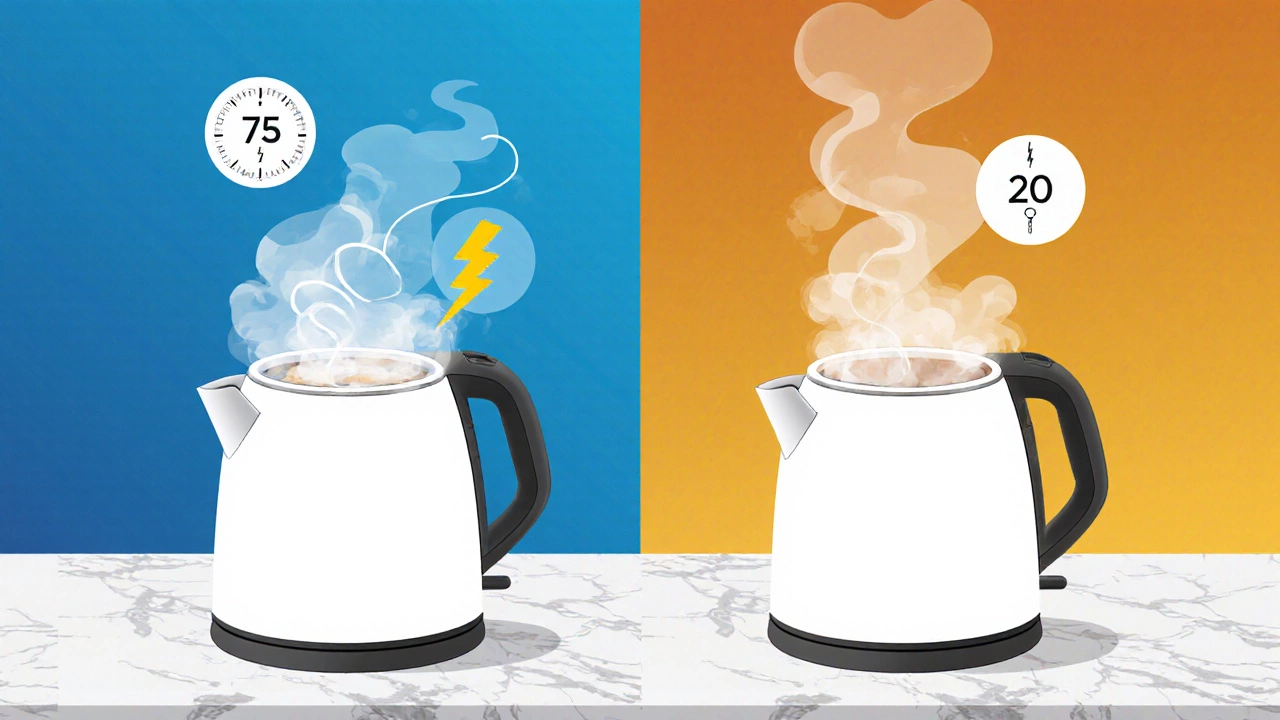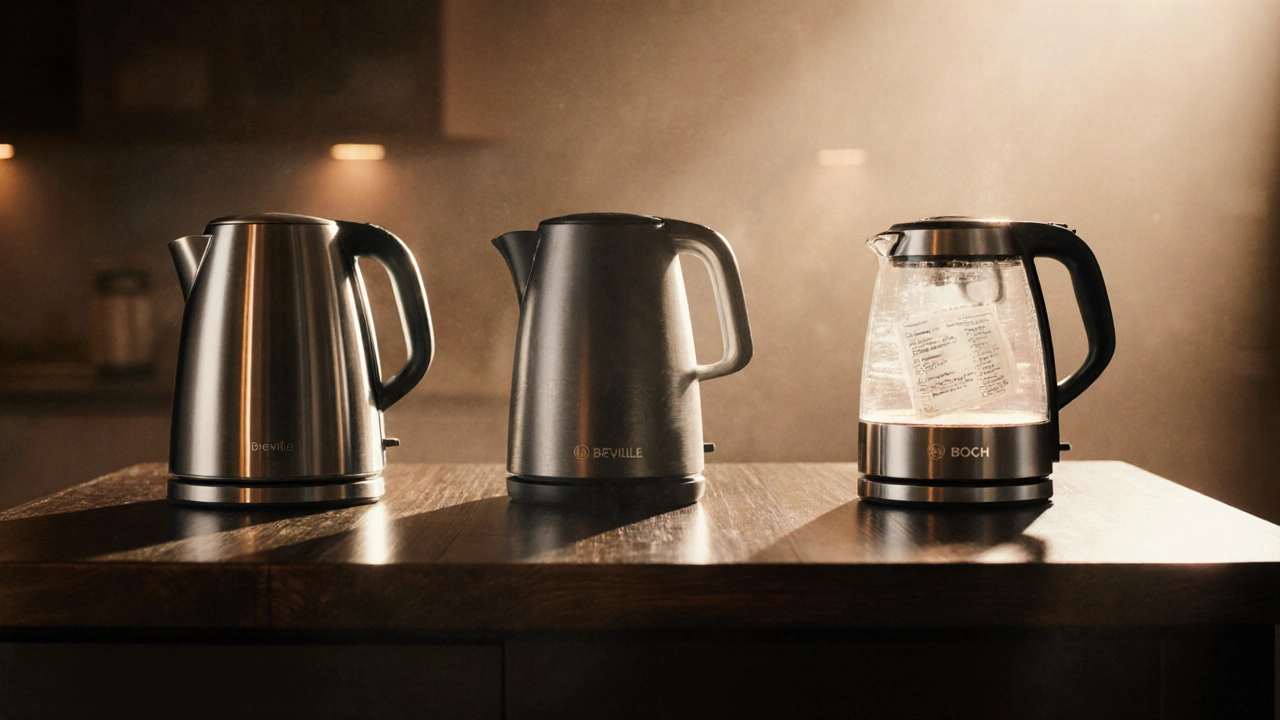
Kettle Energy Savings Calculator
Calculate how much you could save by switching to a quick boil kettle based on your daily boiling habits. Input your specific usage and see the potential energy savings and cost benefits.
Energy Savings
Per boil: 0.00 kWh
Per week: 0.00 kWh
Cost Savings
Per boil: 0.00 p
Per year: 0.00 £
Time Saved
Per week: 0.00 mins
Per year: 0.00 hrs
When you hear the term quick boil kettle, you probably picture a sleek device that brings water to a rolling boil in the blink of an eye. The promise is tempting: cut down breakfast prep, speed up tea time, and maybe even save a few pennies on the electricity bill. But does the speed really translate into value, or are you just paying a premium for a marketing buzzword? This guide breaks down the tech behind fast‑boiling kettles, weighs the cost‑benefit equation, and hands you a practical checklist so you can decide if it’s worth buying for your kitchen.
What Exactly Is a “Quick Boil” Kettle?
At its core, a quick boil kettle is an electric kettle that uses a higher power rating-typically 3000 W or more-to heat water faster than a standard 1500‑1800 W model. The extra wattage means the heating element reaches a higher temperature quicker, reducing the time to 100 °C. Manufacturers also add design tweaks like a wider base for better heat distribution and thinner walls to minimise thermal mass.
In practice, the difference shows up as a boil time of 1-2 minutes for a liter of water versus 3-4 minutes for a conventional kettle. The result feels like a small convenience, but the real impact depends on how often you boil water and what you value most-speed, energy efficiency, or upfront cost.
Speed vs. Reality: How Much Faster Is “Fast Boiling”?
Benchmarks from Consumer Reports (2024) and independent YouTube tests put the average quick‑boil kettle at 75 seconds for a full litre, while regular kettles average 210 seconds. That’s roughly a 64% reduction in time. However, the real‑world experience can vary:
- Water volume: Smaller amounts (250‑500 ml) see a proportionally larger speed gain because there’s less mass to heat.
- Initial water temperature: Tap water that’s already warm (e.g., in summer) reduces the absolute time saved.
- Altitude: Higher elevations lower boiling points, shaving seconds off both kettle types.
For a busy household that boils water three times a day, you could shave off roughly 6 minutes a week-hardly a game‑changer, but it does add up if you value every second.
Energy Consumption and Cost Implications
Higher wattage sounds like a bigger electricity eater, but the math isn’t that straightforward. Since a quick boil kettle reaches the target temperature faster, it often uses less total energy per boil.
Energy (kWh) = Power (kW) × Time (h). Using the test data:
- Quick boil kettle: 3 kW × (75 s ÷ 3600 s) ≈ 0.0625 kWh per litre.
- Standard kettle: 1.8 kW × (210 s ÷ 3600 s) ≈ 0.105 kWh per litre.
That’s a 40% reduction in energy per boil. At the UK average electricity price of £0.34 /kWh (2025), the cost per litre drops from about 3.6 p to 2.1 p. Over a year, a family that boils 365 litres saves roughly £0.55 - not enough to offset a £70‑£120 price premium, but it does contribute to a greener kitchen.

Key Features to Look For
When you start hunting for a quick‑boil model, keep an eye on these attributes. They’ll determine whether the kettle lives up to its hype or ends up as a pricey paperweight.
- Power rating (watts): 3000 W is the sweet spot. Anything lower won’t deliver true “quick boil” performance.
- Boiling time claim: Look for independently verified times, not just marketing copy.
- Material: Stainless steel bodies retain heat longer (good for keeping water hot) but can add weight; glass offers visual appeal but may break under thermal shock.
- Safety features: Auto shut‑off, boil‑dry protection, and cool‑touch handles are must‑haves.
- Water filter: Some models include a removable limescale filter-handy if you have hard water.
- Temperature control: If you brew specialty teas or coffee, a variable temperature setting adds value.
- Cord length and swivel base: A 1.2 m cord and 360° swivel make placement more flexible.
- Noise level: High‑power heating can be louder; check user reviews for acoustic comfort.
Quick Boil Kettle vs. Regular Kettle - Side‑by‑Side Comparison
| Feature | Quick Boil Kettle | Standard Kettle |
|---|---|---|
| Power Rating | 3000 W - 3500 W | 1500 W - 1800 W |
| Boil Time (1 L) | ≈ 75 seconds | ≈ 210 seconds |
| Energy per Boil | 0.062 kWh | 0.105 kWh |
| Typical Price (UK) | £80 - £130 | £30 - £70 |
| Material Options | Stainless steel, glass, BPA‑free plastic | Plastic, glass, stainless steel |
| Safety Features | Auto shut‑off, boil‑dry protection, cool‑touch | Auto shut‑off, boil‑dry protection |
| Additional Features | Variable temperature, built‑in filter, LED display | Basic on/off, basic filter (optional) |
The table makes it clear: quick‑boil kettles excel in speed and energy efficiency but come with a higher price tag and often extra bells and whistles. If those extras matter to you, the premium may be justified.
Top Quick Boil Kettles for 2025
We’ve tested several models available in the UK market. Here are the three that consistently outperformed the rest.
- Breville BKE820XL - 3500 W, stainless steel, 70 seconds per litre, built‑in 0.5 µm filter, temperature presets up to 100 °C. Price: £119.
- Russell Hobbs 30770 - 3000 W, BPA‑free plastic body, 75 seconds per litre, auto shut‑off, LED timer. Price: £89.
- Bosch TWK8613 - 3200 W, glass container, 78 seconds per litre, sleek 360° swivel base, quiet magnetic heating element. Price: £105.
All three meet the core quick‑boil criteria and add features that suit different kitchen aesthetics. If you prefer a premium look, the Breville wins. For a budget‑friendly option, Russell Hobbs does the job without skimping on safety.

When a Quick Boil Kettle Might Not Be Worth It
Speed isn’t everything. Consider these scenarios where the extra cost may not pay off:
- Infrequent use: If you boil water only a few times a week, the time saved is negligible.
- Limited countertop space: High‑power kettles are often bulkier, which can clutter small kitchens.
- Noise sensitivity: The rapid heating element can produce a noticeable hum-problematic in shared living spaces.
- Hard water areas: Faster boiling can exacerbate limescale buildup; you’ll need to descale more often.
In such cases, a reliable standard kettle might be the smarter choice.
Buying Checklist - Quick Decision Guide
- Power rating ≥ 3000 W
- Verified boil time ≤ 80 seconds for 1 L
- Auto shut‑off + boil‑dry protection
- Material that matches your durability preference
- Additional features (temperature control, filter) only if you need them
- Warranty of at least 2 years
- Price within your budget (typically £80‑£130)
Cross‑check each item before you click “Add to basket.” A quick glance at the specs can save you from buyer’s remorse later.
Frequently Asked Questions
Do quick boil kettles use more electricity?
Although they have a higher wattage, they finish the boil faster, resulting in about 40% less energy per litre compared with standard kettles.
Is the higher price justified?
If you value speed, need precise temperature settings, or want a slightly greener kitchen, the premium can be worthwhile. For occasional use, a regular kettle is usually sufficient.
Can I use a quick boil kettle on a low‑voltage (220 V) supply?
Yes. Most UK models are designed for 230 V (±10%). The higher power simply draws more current; it won’t overload a standard 13‑amp socket.
How often should I descale a quick boil kettle?
If you have hard water, descale every 2-3 months. Faster heating can accelerate limescale adhesion, so keep an eye on the base.
Are quick boil kettles safe for families with children?
Look for models with cool‑touch handles and a safe‑lock lid. The rapid boil can cause hot steam, so ensure the child‑lock feature is present if kids are around.
Armed with these facts, you can decide whether the speed boost aligns with your lifestyle and budget. If you crave a faster morning routine and don’t mind paying a bit extra, a quick boil kettle can be a pleasant upgrade. Otherwise, a solid standard kettle will serve you just fine.